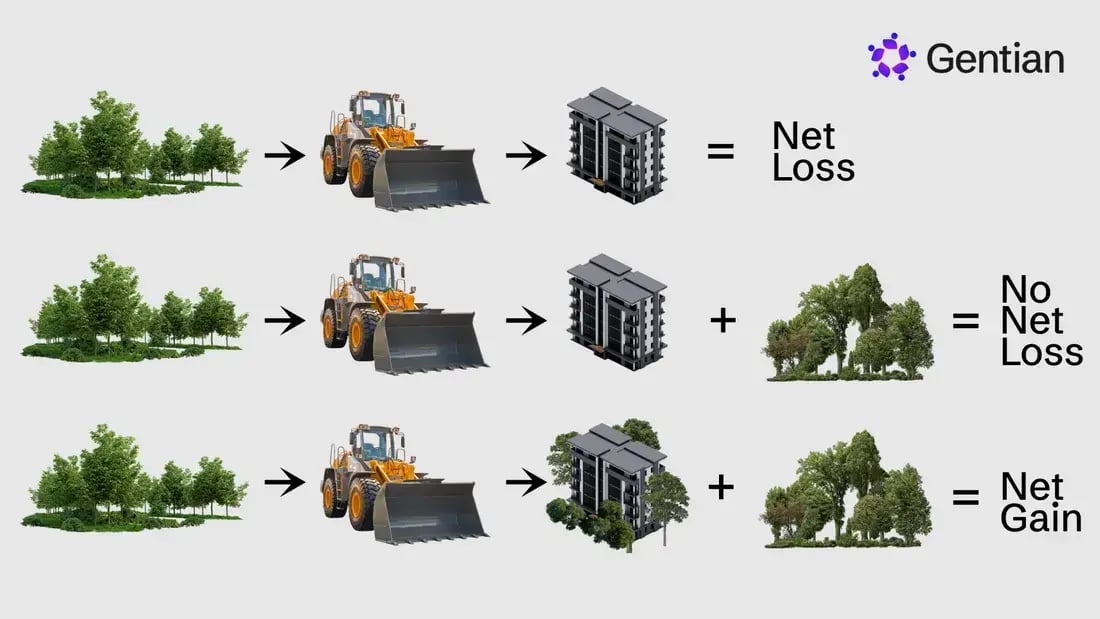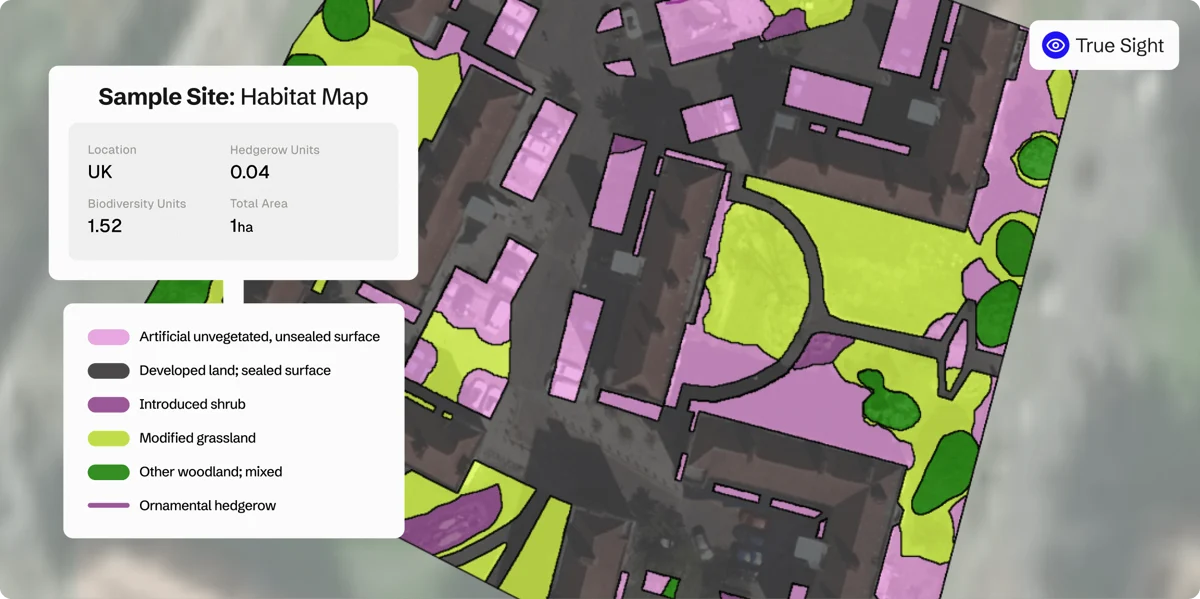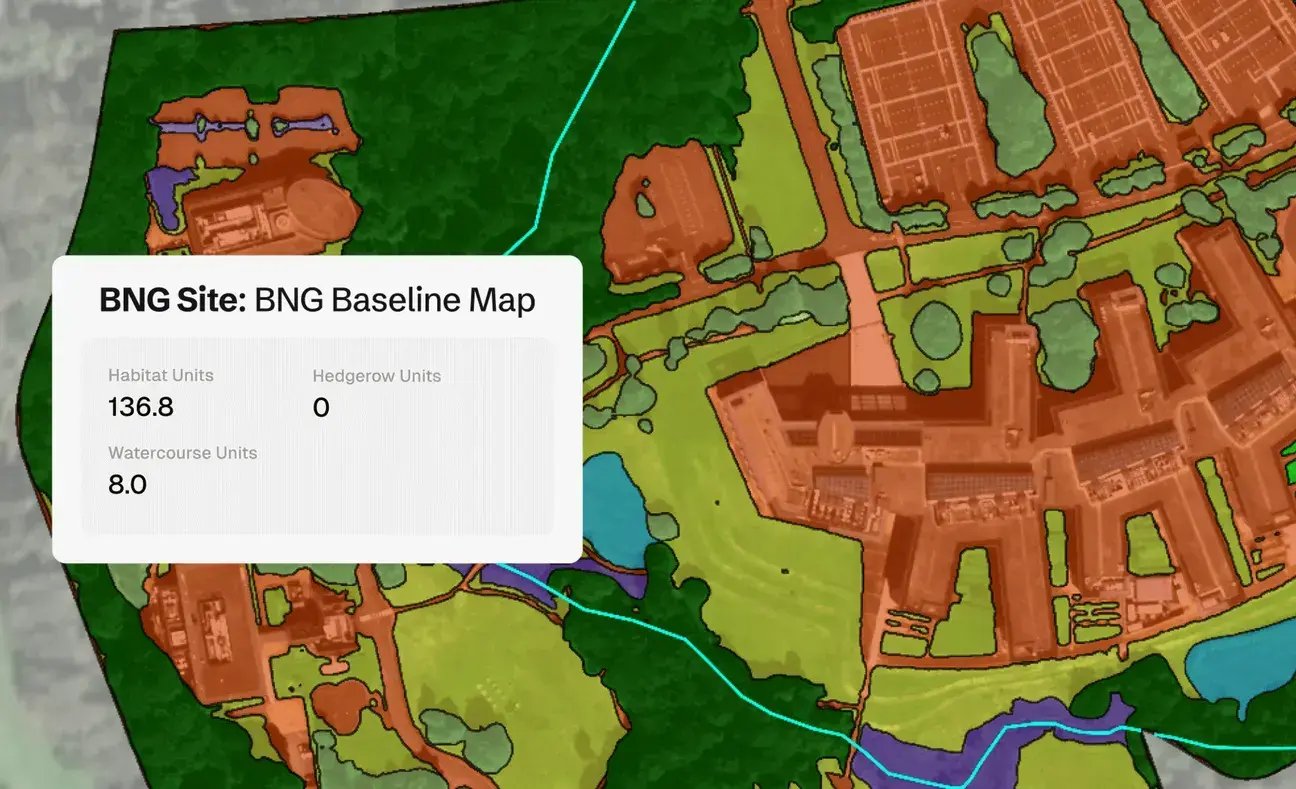Jump to: What is BNG? · Assessment Process · Gain Hierarchy · BNG Register · Calculation · Key Components · Gentian’s Role · Conclusion
For a sector example, see our piece on sport: Could tennis achieve a biodiversity net gain?
What is Biodiversity Net Gain (BNG)?
Biodiversity Net Gain is a UK planning requirement ensuring developments leave nature measurably better than before.
In England, it is now mandatory under the Environment Act 2021 (via an amendment to the Town and Country Planning Act) for most projects to achieve at least a 10% uplift in biodiversity compared to the pre-development baseline.
Equally, this must be evidenced through a standardised metric and secured by planning conditions or legal agreements.
This means developers must enhance or create habitat so that the biodiversity value after development is 110% of its original value.
New or enhanced habitats created for BNG must be maintained for at least 30 years, ensuring improvements are durable rather than short-lived.
Where on-site measures cannot fully achieve the uplift, developers may use off-site units recorded on the national BNG Register, and, only as a last resort, purchase statutory biodiversity credits.
Because the rules combine ecology, mapping, and legal commitments, the BNG assessment is both essential and intricate. Gentian simplifies this process with high-precision data, AI-powered mapping, and ecological expertise, helping teams evidence compliance clearly and efficiently.

Key BNG legislation provisions:
- Mandatory 10% Net Gain: Projects must achieve a minimum 10% increase in biodiversity units, calculated using a standard metric, applied separately to different habitat types.
- 30-Year Habitat Protection: New/enhanced habitats for BNG must be secured and managed for at least 30 years via planning obligations or conservation covenants.
- On-Site and Off-Site Options: BNG can be achieved on-site, off-site, or (as a last resort) by purchasing statutory biodiversity credits, prioritising on-site solutions.
- BNG Register: A national register records off-site habitat gains, allowing developers to allocate off-site units to projects.
- Legal Protections and Scope: BNG requirements supplement existing protections (rather than overriding them) and apply to most developments, with irreplaceable habitats (e.g., ancient woodland) treated separately.
See our Biodiversity Net Gain Assessments page for more information.
The BNG Assessment Process: A Step-by-Step Guide
A robust BNG assessment follows three linked stages that translate habitats into “biodiversity units”, compare before and after, and secure the 10% uplift.
Stage 1: Establishing the Baseling
The first stage is all about understanding what’s on the site before any development happens. This involves a detailed baseline biodiversity survey of the site’s habitats and ecological features.
Baselining begins with a pre-development biodiversity survey to map habitat types (using UKHab), assess condition, and record extent (area or length).
Using the Defra Biodiversity Metric (the Statutory Biodiversity Metric baseline habitats are used to calculate the site’s biodiversity units. These units are calculated based on:
- Habitat Size: The area or length of the habitat (in hectares for area habitats, or kilometers for linear features like hedges).
- Habitat Type (Distinctiveness): A score reflecting the rarity or ecological importance of the habitat type. Common habitats have lower distinctiveness, while rarer or more valuable habitats score higher.
- Habitat Quality (Condition): A rating of how ecologically healthy or intact the habitat is, determined by specific criteria (e.g. species diversity, absence of invasive species).
- Habitat Location (Strategic Significance): A factor considering if the habitat is in a location that’s a local conservation priority or connected to broader ecological networks.
Establishing an accurate baseline is crucial. It’s the reference point against which the post-development scenario will be compared. Accuracy matters: misidentifying a habitat or over-estimating condition can skew all later calculations. High-resolution imagery and QA by ecologists reduce error and support auditability.
Step 2: Calculating the Post-Development Score
After establishing the baseline, the next step is to calculate the post-development biodiversity value. This involves superimposing proposed site plans onto the ecological baseline to assess changes.
Key considerations include: habitat loss or degradation, and new habitats created or enhanced on-site through landscaping or mitigation. The metric quantifies units lost for removed habitats and units gained for created or improved ones.
Ecologists use the BNG Metric tool to calculate habitat changes. For example, losing 1 hectare of grassland requires offsetting gains, such as creating a wildflower meadow.
The metric compares "before and after" development units, considering habitat size, quality, type, and location. This is often an iterative process, with ecologists, planners, and designers collaborating to achieve a favorable balance.
For the post-development scenario, the metric is re-run, incorporating time-to-target and difficulty risk multipliers. Trading rules are then applied to ensure that like-for-like (or better) outcomes are achieved for distinctive habitats.
By the end of Stage 2, there should be a clear calculation showing pre-development units vs. post-development units. If the post-development total (including on-site habitat creation/enhancement and any off-site plans) is at least 10% higher than the baseline, the project meets the minimum BNG requirement.
The calculations and habitat maps from this stage form a core part of the Biodiversity Gain Plan submitted with the planning application.
Step 3: Achieving the 10% Net Gain
The final stage focuses on implementation strategies. How to actually achieve that required uplift in practice and demonstrate compliance. There are several pathways to secure the 10% net gain, often used in combination:
- On-Site Habitat Enhancements: Prioritise improving existing habitats or creating new ones within the project site. These must be managed for 30+ years.
- Off-Site Solutions: If on-site gains are insufficient, developers can improve habitats on other land they own or purchase biodiversity units from external providers. These units must be registered with Natural England and have a 30-year legal agreement.
- Biodiversity Credits: As a last resort, developers can buy costly statutory credits from the government, which fund national habitat creation. This is discouraged due to expense and the aim to promote other options.
The biodiversity gain hierarchy (avoid, mitigate, compensate on-site, then off-site, then credits) guides this iterative process. The final Biodiversity Gain Plan outlines the entire strategy for achieving and maintaining the 10% net gain.
What is the Biodiversity Gain Hierarchy?
The Biodiversity Gain Hierarchy guides how to achieve net gain, ensuring avoidance and on-site action come first. It is a core expectation in new planning applications and underpins credible BNG assessments.
- Avoiding adverse effects on habitats, particularly those with medium, high, and very high distinctiveness.
- Mitigating unavoidable adverse effects.
- Compensating for unavoidable effects through on-site habitat enhancement or creation.
- Using registered off-site biodiversity gain.
- As a final option, purchasing statutory biodiversity credits.
The biodiversity gain hierarchy mandates a disciplined approach: protect first, mitigate second, and compensate last, ideally near the impact site.
This ensures developers comply with BNG rules and uphold good conservation. Planning authorities will verify how this hierarchy was applied in Biodiversity Gain Plans, preventing easy, distant fixes and encouraging the integration of biodiversity from the outset.
What is the BNG Register?
The BNG Register is Natural England’s public register for off-site biodiversity units.
Landowners use it to record land that will deliver BNG; developers use it to find and allocate off-site units to specific projects. Entries indicate the location, habitat types, and unit allocations linked to developments.
Key checks before registration (landowner):
- Proof of ownership/control: Legal right to use the land for habitat gains (e.g., title deeds, lease agreement).
- 30-year legal agreement: Land secured for at least 30 years for conservation, usually via a Section 106 agreement or conservation covenant.
- Biodiversity metric calculations: A Statutory Biodiversity Metric assessment quantifying baseline and expected biodiversity units.
- Habitat management and monitoring plan: A detailed plan for habitat creation, management, and monitoring over 30+ years.
- Boundary maps and supporting info: Site boundary maps and a local land charge search.
There is a registration fee (£639 as of 2024), and Natural England responds within six weeks. Successful registration provides a unique gain site reference number.
For developers, the BNG Register ensures transparency and prevents double-counting of off-site units. They can search the register for available habitat banks, seeing location, habitat types, and unit availability. This guarantees legitimate, lasting biodiversity improvements.
In essence, the BNG Register is crucial for the net gain system's integrity, formally logging and tracking off-site biodiversity gains after rigorous checks.
How is BNG Calculated?
BNG is calculated using the Statutory Biodiversity Metric, a free government tool that converts habitats into biodiversity units.
It compares pre- and post-development values to show the net change. Four core factors drive the calculation (Habitat Size, Habitat Quality, Habitat Type, and Habitat Location).
The process involves:
- Baseline Units: Assessing pre-development ecological value based on habitat area, condition, distinctiveness, and strategic location.
- Post-Development Units: Calculating units after development, accounting for retained, lost, and newly created/enhanced habitats, factoring in establishment time, risk, and trading rules.
- Net Gain Calculation: The goal is a +10% or more increase in units across all habitat categories (e.g., area, hedgerow, watercourse).
The formula aggregates unit totals and requires a ≥10% gain for each unit type present so one cannot compensate for another.
In short, a how to calculate net gain exercise: if baseline equals 100 units, the post-development plan must evidence ≥110 units for each relevant category. Failure to meet this 10% uplift can lead to planning refusal or require project revisions, potentially through off-site unit acquisition.
The metric is habitat-based, not directly counting species, and is the accepted tool for developers, planners, and ecologists to ensure consistent evaluation and enforceable net gain targets. This rigorous quantification ensures BNG is a measurable, evidenced requirement.
Key Components of BNG
Achieving Biodiversity Net Gain involves several interconnected components.
Beyond just the metric and percentages, there are specific plans, concepts, and safeguards that ensure BNG is delivered meaningfully.
Below, we break down some key components of a successful BNG process, each of which you may encounter when navigating net gain requirements:
The Biodiversity Metric
The Biodiversity Metric is the statutory tool for calculating Biodiversity Net Gain (BNG).
It quantifies biodiversity value by assessing habitat size, quality, type, and strategic importance, based on the UK Habitat Classification. The metric includes "trading rules" to prevent inappropriate habitat swaps.
Familiarity with this "calculator" is crucial for practitioners, ensuring transparency and comparability in BNG assessments. It comes with a detailed user guide and condition assessment sheets.
The Biodiversity Gain Plan
The Biodiversity Gain Plan (BGP) is a mandatory document for developments subject to BNG.
It must be submitted and approved by the local planning authority before development begins, outlining how the project will achieve its net gain.
Key elements include: baseline biodiversity value, harm avoidance measures, post-development habitat plans, on-site creation/enhancements, off-site units, and credit purchase proof.
The BGP also details 30-year habitat management and monitoring, plus legal agreements. LPAs have 8 weeks to review and approve or reject the plan.
A well-prepared BGP is crucial for avoiding delays, serving as the formal net gain strategy that encompasses both the data and the practical delivery of biodiversity gains.
Irreplaceable Habitats
Irreplaceable habitats (e.g., ancient woodlands, peat bogs) are high-value ecosystems that cannot be recreated.
They are excluded from standard BNG calculations; a 10% net gain cannot offset their loss, and the 10% requirement doesn't apply to them.
Instead, impacts trigger stringent planning tests and bespoke compensation plans. While enhancements can be recorded, they don't count towards the 10% gain for other habitats.
The priority is to avoid impacting these "hands-off" habitats, highlighting that BNG involves ecological judgment, not just metrics. Their presence signals a "red flag" for developers.
Securing the Gain
A crucial aspect of Biodiversity Net Gain (BNG) is ensuring that promised biodiversity enhancements are actually delivered and maintained long-term.
"Securing the gain" involves legal and practical mechanisms to protect and manage new or improved habitats for a minimum of 30 years, as mandated by law. This prevents gains from being undone post-project.
Key methods for securing the gain include:
- Planning Conditions and Obligations: Local planning authorities use planning conditions or Section 106 agreements to legally require habitat delivery and management, enforceable by law.
- Conservation Covenants: These voluntary, legally binding agreements bind current and future landowners to conservation duties, securing off-site habitat sites.
- Monitoring and Reporting Requirements: Ongoing monitoring, typically through a Habitat Management and Monitoring Plan (HMMP), ensures habitats are improving. Regular reports track progress and address issues.
- Financial Securities: For larger schemes, financial bonds or endowments may secure long-term management funds, ensuring upkeep even if the original developer is no longer involved.
"Securing the gain" ensures new habitats aren't neglected. This framework of legal agreements guarantees BNG delivers lasting benefits for 30 years. Off-site units need security evidence, and on-site enhancements are usually tied to conditions.
While some developments are exempt (e.g., very small projects, householder extensions), longevity of gains is non-negotiable for most, marking a new era of accountability in planning.
Gentian’s Role in a Streamlined BNG Assessment
Gentian revolutionises Biodiversity Net Gain (BNG) assessments with a tech-driven, ecologically rigorous approach built on four pillars.
- Precision Data: Very-high-resolution satellite imagery and AI-driven models deliver accurate baselines, reducing survey gaps and improving confidence in unit totals.

- Unmatched Speed and Ease: Insights arrive in days, not months. Rapid site screening and scenario testing help teams redesign early, avoiding costly late-stage rework.
- Visionary Expertise: Our ecologists and AI specialists validate outputs, from habitat design tweaks to off-site unit strategy.
- Trusted Partner: Flexible support for a single site or whole portfolios. We integrate with your planning workflow and stay aligned with evolving guidance so your biodiversity net gain assessment remains compliant.
This approach avoids common pitfalls, leading to faster approvals, reduced costs, and better biodiversity outcomes, streamlining every step from baseline mapping toimplementing net gain solutions.
Empowering BNG with Clarity and Confidence
BNG doesn't have to be daunting. This guide shows that successful BNG assessments rely on accurate data, careful planning, and long-term habitat stewardship.
By explaining what BNG is, how to measure it, the gain hierarchy, and regulatory tools like the BNG Register, we aim to equip you with confidence.
The core idea is simple: development and nature can coexist.
With partners and tools, complex environmental rules become manageable. Gentian's mission is to make BNG clear and achievable, merging technology with ecology.
By using data-driven solutions and expert guidance, businesses and planners can ensure a 10% net gain isn't just a compliance exercise, but a meaningful step towards a nature-positive future where both businesses and nature thrive.
For further reading or support, explore our resources and services on Biodiversity Net Gain Assessments. Take the next step towards streamlined, successful BNG compliance and get in touch with a member of our team via the form below:

.jpeg?width=400&height=250&name=Untitled%20(5).jpeg)


.jpeg?width=400&height=250&name=Untitled-2%20(3).jpeg)